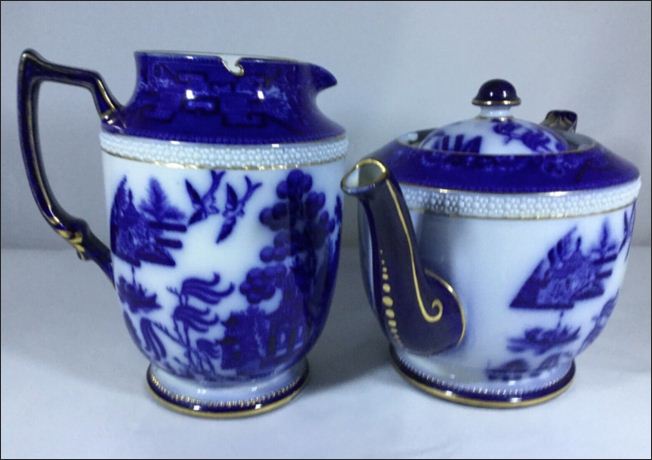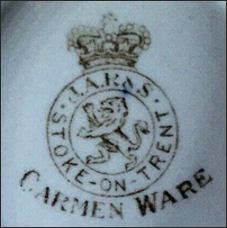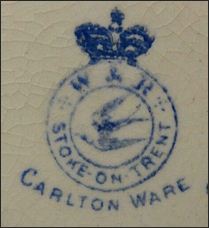![]()
|
J.
A. Robinson & Sons Ltd |
Location and period of operation:
|
J.
A.
Robinson & Sons Ltd |
1910 |
c.1934 |
|
Manufacturer of earthenware and china at numerous North Staffordshire potteries. The head office was based at Wolfe Street, Stoke, Stoke-on-Trent. Although the comany was named J. A. Robinson & Sons Ltd it was one of the sons - Harold Taylor Robinson who was the driving force behind the business.
James Alcock Robinson James Alcock Robinson (b.1852) - in the 1891 census he was recorded as an earthenware manufacturer, living at Park Cottage, Silverdale Road, Wolstanton. Married to Mary Taylor, they had three sons - Harold Taylor Robinson age 13, Clive B Robinson age 9 and Herbert (Hubert) A Robinson age 6.
Wiltshaw & Robinson In 1890 James Alcock Robinson and his brother William Herbert Robinson joined James Wiltshaw as partners in the newly formed company Wiltshaw and Robinson. In 1899 Harold Taylor Robinson (son of James Alcock Robinson) joined Wiltshaw & Robinson as a commercial traveler. In 1906 Harold Taylor Robinson replaced his uncle, William, as a director of the company and this was reflected by the change of name for a brief period to Wiltshaw, Robinson & Son Ltd. In 1911 a split occurred with the partners of Wiltshaw & Robinson - James Wiltshaw bought out the Robinsons and became sole proprietor of the company in 1911 amidst much rancour.
In 1899 Harold Taylor Robinson (son of James Alcock Robinson) joined Wiltshaw & Robinson as a commercial traveler. Around 1904 Harold Taylor Robinson formed his first company Arkinstall & Son. to manufacture the heraldic china that had been popularized by William Henry Goss. In the same year he took over the business of Charles Ford and china manufacturer in Hanley. Over the next decade Harold Taylor Robinson acquired other makers of heraldic china, and in 1910 he formed the company J. A. Robinson & Sons Ltd (named after his father) as a holding company for his many pottery businesses. subsidiary or associated businesses included:
Brown-Westhead, Moore & Co. - Cauldon Ltd. In 1920 Harold T. Robinson purchased from its receiver the business of Brown-Westhead, Moore & Co. trading as Cauldon Ltd. This large business operating at Cauldon Place, Shelton, had been owned by the Ridgeway family, but in 1920 was in receivership. Robinson purchased the business from the receiver for £100,000, borrowing £75,000 to fund the purchase. He then formed a new company Cauldon Potteries Ltd with an issued capital of £250,000 amalgamating the various Robinson owned companies with the new business. Cauldon Ltd (Brown-Westhead, Moore & Co.) Robinson then sold-on to Cauldon Potteries Ltd taking as his consideration £90,000 in fully paid Cauldon Potteries Ltd shares. It is perhaps not surprising to learn that H. T. Robinson was the Chairman and Managing Director of Cauldon Potteries Ltd and that the other directors were his father J. A. Robinson, brother Hubert Robinson and close associate John Vivian Goddard. Between 1920 and 1930 other companies were added to the Cauldon empire including:
Other interests In addition to the acquisition of the pottery manufacturers there were purchases of coal and clay suppliers and of pottery wholesalers. In 1927 Harold T. Robinson acquired control of Royal Crown Derby Porcelain Co. Ltd. In October 1930 Robinson entered into a contract to purchase the Worcester Royal Porcelain Co. Ltd. The shares in Worcester Royal Porcelain Co. Ltd were eventually acquired but the world financial crisis was gradually enveloping Robinson and his Cauldon empire and the Worcester business was still operating under control of its receiver in 1932.
The decline By 1932 Robinson was the largest pottery manufacturer in the country and his empire extended to around 30 companies. Robinsonís businesses, especially those exporting to North America suffered from the effects of the Great Depression and in 1932 Cauldon Potteries Ltd was placed in receivership by its debenture holders (Harold Taylor Robinson was seperatly declared bankrupt at about the same time). The Statement of Affairs tabled in June 1932 showed gross liabilities of £238,706 12s. 4d. (but of which only £33,546 9s. 3d was expected to rank). Against this were gross assets of £1,536 17s. 6d. The ensuing public examination of Harold Taylor Robinsonís business affairs recorded in the Pottery Gazette reveals an incredibly tangled web of company purchases and sales, share issues, borrowings Ė many from close friends and business associates - loan guarantees, undertakings to purchase shares and so on. Many questions from the Official Receiver referred to the multitude of inter-company transaction by companies of which Robinson was a Director and/or held a controlling interest. The application of discharge from bankruptcy was heard in February and April 1934. Remarkably, Robinsonís liabilities had been reduced from the gross liability of £238,706 12s. 4d reported in May 1932 to around £2,800. The Receiver stated that the debts had either been bought up and the claims cancelled, or that the trustees had received letters stating either that no claim existed or that the debt had been satisfied by the existing security. Harold Taylor Robinson eventually obtained his release from bankruptcy and although the facts of the case are well reported in the Pottery Gazette, there are only hints of an even more complex and personal story. Few, if any, members of the public lost money in the devastating collapse of his personal and business empire. His close friends and associates appear to have supported him through the period of bankruptcy, even buying up and cancelling Robinsonís liabilities.
The development of Cauldon Potteries Ltd The Cauldon Potteries Ltd assets were sold and Cauldon Potteries Ltd and its Coalport subsidiary were acquired by Harrison & Son (Hanley) Ltd. In 1935 the Harrisons consolidated their pottery interests at their George Jones & Sons Ltd (Crescent China) works and the three firms (George Jones, Cauldon and Coalport) operated as a group although maintaining their separate identities. Robinson
returned to work for the Crescent Potteries group as Ďsales
coordinatorí but ill-health caused him to retire from this position in
1936.
The future of Harold Taylor Robinson In 1939 Robinson moved to Derby and continued his interest in Royal Crown Derby Porcelain Co. Ltd. He had acquired control of the company in 1927 and for several years had been its Chairman, and how this interest survived his bankruptcy, if indeed it did, can only be the subject of speculation. Nevertheless, by 1939 he held a controlling interest in the Royal Crown Derby Porcelain Co. Ltd and became its Chairman. Under his direction the business expanded considerably, increasing employee numbers fourfold and sales and exports by sevenfold by 1950. Robinson became a leading citizen of Derby, hosting a visit by Queen Elizabeth to the Derby factory in 1949 and celebrating the bicentenary of porcelain manufacture at Derby in 1950. He was appointed Chairman of the Derby and Derbyshire Chamber of Commerce in 1950 and in 1951 was awarded a CBE in the New Yearís Honours. List. He remained the company Chairman until his death in 1953 and was succeed by his son Philip I. Robinson (the Managing Director at the time) as Chairman of the company. much of this information is courtesy Michael Perry "A handbook of British Pottery Manufacturers 1900-2010" and is based primarily on the reports of Harold Taylor Robinsonís bankruptcy proceedings reported in the Pottery Gazette Volumes 57 (1932) and 59 (1934) supplemented by other sources. |
 teapot and hot water jug in a semi-willow pattern probably produced at the factory of Robinson & Leadbeater |
 J.A.R. & S Stoke-on-Trent Carmen Ware |
There was not much ware produced
with a mark of J. A. Robinson & Sons
most ware was marked with the mark of the producing subsidiary
companies
 W & R Stoke-on-Trent Carlton Ware |
 J.A.R. & S Stoke-on-Trent Carmen Ware |
|
The mark on the left (Carlton Ware) is that of Wiltshaw and Robinson - the business was founded in 1890 by James F. Wiltshaw and members of the Robinson family. By 1911, following a period of long standing problems, a split occured and Wiltshaw bought out the Robinsons. The mark on the right was used by J. A. Robinson & Sons for a short period after the the split from Wiltshaw. |
|
Questions, comments, contributions? email: Steve Birks